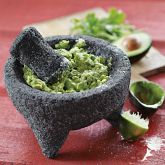Recipe for Guacamole con Tomate Verde and Tomate Riojas adapted from Diana Kennedy:
3 tbsp. finely chopped white onion
4 chiles serranos, finely chopped
2 rounded tablespoons, finely chopped cilantro
Scant ½ tsp. sea salt
6 oz or 8 medium tomatillos (broiled—method follows)
3 large Avacados
1 cup finely chopped unpeeled tomato
For the topping:
2 tbsp. finely chopped white onion
1 heaping tbsp. finely chopped cilantro
1. First, broil the tomatillos. Remove the papery husk and rinse the tomatillos. Don’t attempt to skin them. Put the tomatillos into a heavy cast iron pan. Put them under the broiler and cook them until they are fairly soft and the skin is lightly charred (About 5 minutes) When you grind them, include the skin.
2. In the molcajete, grind the onion, chiles, cilantro and salt to a paste. Add the broiled tomate verde, a few at a time, mashing and grinding the skin as much as possible.
3. Cut the avocados in half and remove the pits but do not discard. Scoop out the flesh with a wooden spoon and mash roughly into the base mixture, turning it over from the bottom so that the seasoning is well distributed. Put the pits back into the mixture.
4. Wait until the last minute to add the diced tomato, mixing it in.
5. Sprinkle the top with onion and cilantro and serve immediately.

.jpeg)
 To inaugurate my new molcajete, I turned to the legendary Diana Kennedy and her wonderful book, a gift from Carlos’ prior visit, “The Art of Mexican Cooking” (Clarkson Potter 2008). Diana Kennedy is likely the English-speaking world’s foremost authority on Mexican cooking. Born in England, she emigrated to Canada in 1953. In 1957, she went to Mexico and married Paul Kennedy, a New York Times correspondent. After nine years of studying and collecting Mexican recipes, she and her husband moved to New York City in 1966. Sadly, her husband died a year later. Craig Claiborne, his colleague at the Times, pressed her into giving Mexican cooking lessons. She did and when not teaching, she returned to Mexico time after time until she had enough material to publish her first cookbook in 1972. Her literary output now includes 8 cookbooks and the Government of Mexico acknowledged her with its highest possible honor. She was awarded the Order of The Aztec Eagle for her contributions in documenting Mexico’s regional cuisine. This accolade is the Mexican equivalent of a knighthood for non-Mexicans. And to this day, aged 89, Diana Kennedy continues to live and write in Mexico. Most recently, she was featured in Saveur Magazine’s August/September 2012 “The Mexico Issue”.
To inaugurate my new molcajete, I turned to the legendary Diana Kennedy and her wonderful book, a gift from Carlos’ prior visit, “The Art of Mexican Cooking” (Clarkson Potter 2008). Diana Kennedy is likely the English-speaking world’s foremost authority on Mexican cooking. Born in England, she emigrated to Canada in 1953. In 1957, she went to Mexico and married Paul Kennedy, a New York Times correspondent. After nine years of studying and collecting Mexican recipes, she and her husband moved to New York City in 1966. Sadly, her husband died a year later. Craig Claiborne, his colleague at the Times, pressed her into giving Mexican cooking lessons. She did and when not teaching, she returned to Mexico time after time until she had enough material to publish her first cookbook in 1972. Her literary output now includes 8 cookbooks and the Government of Mexico acknowledged her with its highest possible honor. She was awarded the Order of The Aztec Eagle for her contributions in documenting Mexico’s regional cuisine. This accolade is the Mexican equivalent of a knighthood for non-Mexicans. And to this day, aged 89, Diana Kennedy continues to live and write in Mexico. Most recently, she was featured in Saveur Magazine’s August/September 2012 “The Mexico Issue”. 
.jpeg)










